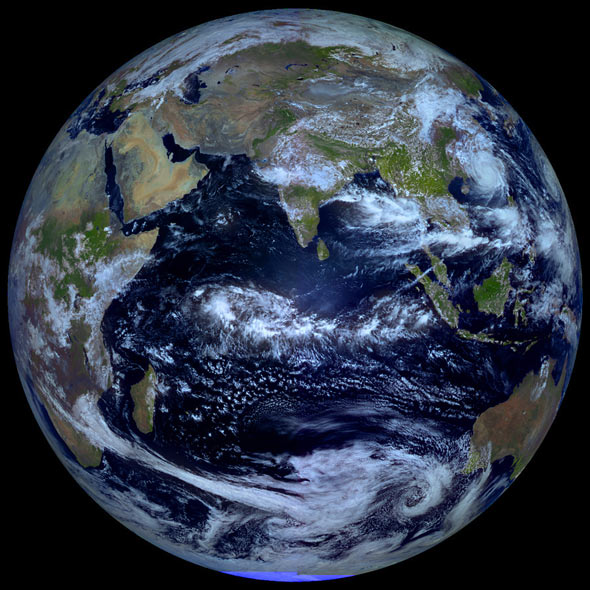The Autumnal Equinox … FROM SPACE!

Photo by Roscosmos / NTSOMZ/ SRC "Planeta" / zelenyikot.livejournal.com
A few days ago—Sunday at 20:44 UTC
(4:44 p.m. EDT), to be exact—was the moment of the autumnal equinox.
There are a number of ways to explain this, though the definition is
that it’s the moment the center of the Sun’s disk has a declination of zero degrees when it’s moving southward in its annual path across the sky.
Not very enlightening, is it? Well, unless you’re an astronomer.
Another way to say it is that the Sun was directly over the Earth’s
equator, illuminating equally the Northern and Southern hemispheres.
This happens twice a year, the other time being at the vernal (spring)
equinox in March.
The word equinox itself means equal night, referring to the idea that daytime and nighttime are the same length on that day. In reality that’s a misnomer; the Earth’s atmosphere acts like a lens,
making the Sun rise a few minutes earlier than it would if the Earth
were airless, and set a few minutes later as well. So daytime on the
equinox is actually a few minutes longer than night. The more you know.
But the equinox makes itself known if you look at the Earth from space. The picture above is from the Russian weather satellite Electro-L. This orbits our planet high above the equator, in what’s called a geosynchronous orbit.
The time it takes to circle the Earth once is 24 hours, the same amount
of time it takes the Earth to spin once. To the satellite, it appears
to see the same face of the Earth all the time; to us on the ground, the
satellite appears frozen in the sky, occupying one spot in space.
The picture shows the Earth on the day of the equinox, taken at about
05:30 UTC (01:30 EDT), 15 hours before the actual moment of the
equinox. Still, close enough. It’s lovely, isn’t it? The picture is a
combination of visible light (the kind we see) and near infrared, which highlights vegetation. The IR is given a green tint in the picture to make it look more natural to our landlubber eyes.
More importantly, note the illumination: The entire northern and
southern hemispheres are lit! If you were on the north pole or the south
pole, you’d see the Sun sitting right on the horizon. Of course, for
the former the Sun gets lower every day, marking the oncoming winter.
For the south pole, the Sun gets higher, meaning summer is coming.
The image was processed by journalist and space enthusiast Vitaliy Egorov.
He also put together a day’s worth of images from Elektro-L (ranging
from Sep. 20 at 20:30 to Sep. 21 at 15:30 UTC) into this very cool
animation:
Remember, from the point of view of the satellite, the Earth sits motionless underneath it … but our atmosphere is anything but. You can see clouds swirling, the shadow line between day and night sweep across the globe, and even the reflection of the Sun in the waters beneath. In the images used, the infrared images are colored red, which gives our planet an odd, Mars-like hue.
I’m fascinated by the clouds. You can see the huge (and deadly) typhoon Usagi
about to slam into China (in the still frame above, taken two days
later, you can see it’s moved west), and the enormous swath of clouds
splayed across the southern Indian Ocean (note again in the still frame
the eastern tip has developed into a curled shape by the Coriolis effect).
I think if I lived in space, once I stopped throwing up everything I’ve
ever eaten since I was born, I could simply gaze out the porthole at
our spinning globe. Maybe this is just a billion years of evolution
speaking, but I think our planet is a fantastic place, pleasing to the
eye and to the brain as well. We’ve been living on it for a long, long
time, but sometimes you need to get up and above it to truly appreciate
its beauty.



0 Comments:
Post a Comment
<< Home